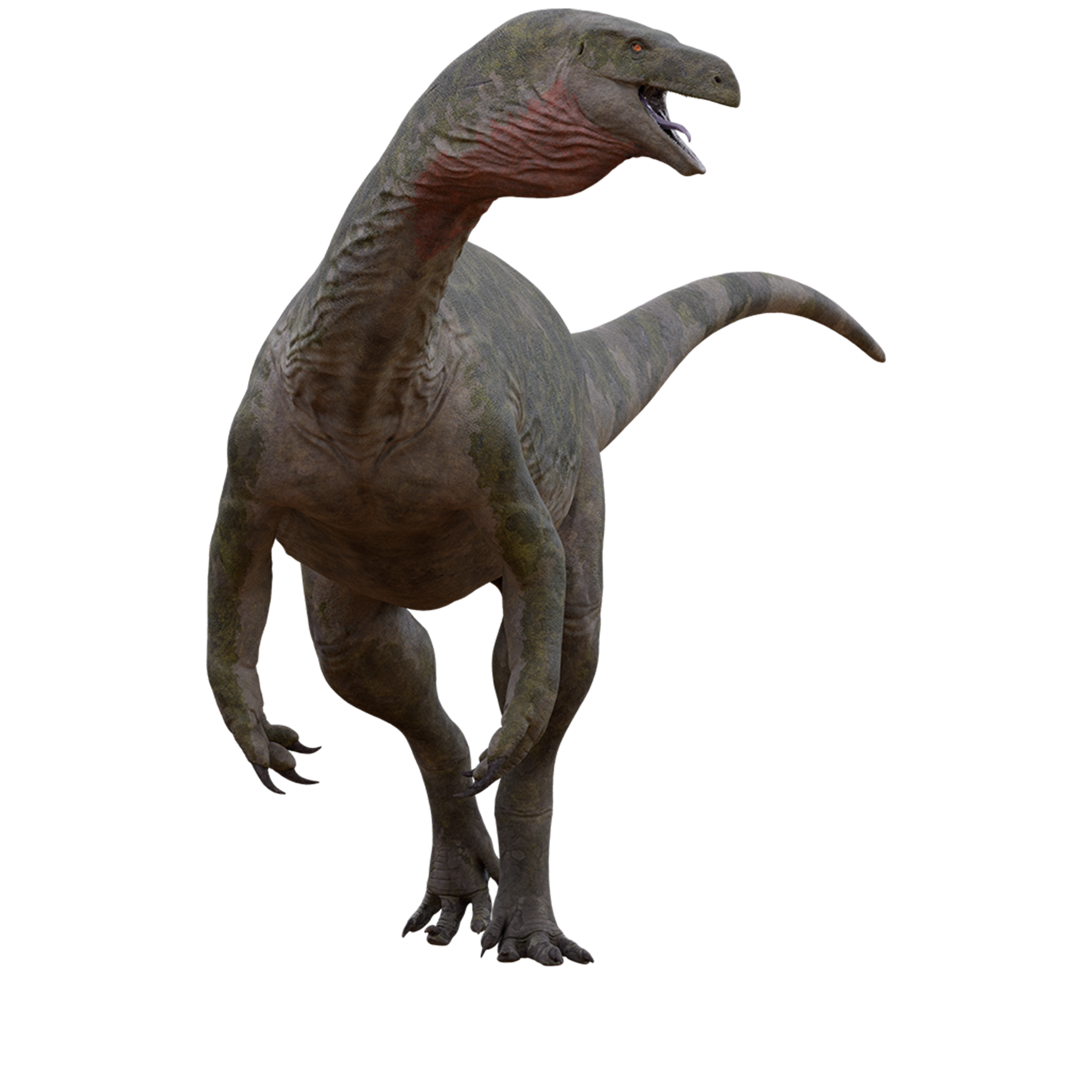The Little Long-Neck from the Dawn of the Dinosaurs
This Triassic herbivore from Brazil had yet to achieve the large size of later sauropodomorphs, but it already had the iconic long neck that would come to characterize the group.
Overview: 125 million years ago in the cradle of dinosaur evolution, South America, lived a small animal with a big future. Unaysaurus, discovered in 1998 and named in 2004 by Luciano A. Leal and colleagues, was one of the earliest known members of Sauropodomorpha, a group that would one day include the biggest animals to ever walk the earth, and some of the most famous of dinosaurs! Though Unaysaurus was no larger than a human, it already showed some of the telltale features that identify it as an early relative of the giants that would go on to dominate the Jurassic and Cretaceous.
Discovery: Unaysaurus tolentinoi was discovered by Tolentino Marafiga on the side of the road in the geopark of Paleorrota, near the city of Santa Maria in the southern Brazilian state of Rio Grande do Sul. It was preserved in rocks of the Caturrita Formation, dating to about 125.42 Ma during the Norian Age of the Late Triassic Period. The animal was described and named in 2004 by Luciano A. Leal, Sergio A. K. Azevodo, Alexander W. A. Kellner, and Átila A. S. da Rosa. The genus name is derived from the word “unay” (u-na-hee), which is a Tupi word meaning "black water", referring to Agua Negra, "black water” in Portuguese, name for the region where the fossils were found, and the Greek word “sauros”, meaning lizard. So Unaysaurus can be translated as “Black Water Lizard” or “Lizard of Agua Negra”. The species name, tolentinoi, honors Tolentino Marafiga who first discovered the fossils. The specimen is well preserved, with a nearly complete skull and lower jaw, and portions of the postcranial skeleton that were articulated (attached and in more or less natural position), making Unaysaurus one of the most complete dinosaurs ever found in Brazil. In 2023, a second specimen, a juvenile from the same locality as the holotype, was described by Rodrigo T. Müller and colleagues.
Evolution: Unaysaurus belongs to the clade Sauropodomorpha, which includes, most famously, the sauropods, as well as their earlier relatives, sometimes called “prosauropods”. Within these non-sauropod sauropodomorphs, Unaysaurus is in the family Unaysauridae, which also includes Macrocollum, also from Brazil, and Jaklapallisaurus from India. However, it was originally classified as a member of Plateosauridae, and there is some evidence to suggest that unaysaurids are actually plateosaurids. Either way, Unaysaurus was a close relative of the famous Plateosaurus that lived 15 million years later in Germany. While today it would seem strange to find such closely related animals so far apart, back in the Triassic, all of the continents were combined into the supercontinent of Pangea, making it easy for animals and plants to spread across the world.
Description and Ecology: Like most early dinosaurs, Unaysaurus was small. It weighed only about 70 kilograms (150 lbs) and from nose to tail it was only about 2.5 m (8.2 ft) long. Like the carnivorous theropods to which it was distantly related in the clade Saurischia, Unaysaurus was bipedal, However, despite its stance and its small size, Unaysaurus was already showing traits that would go on to define the sauropods. It had a proportionally small head at the end of a rather long neck, and it had the very beginnings of a stocky, barrel-shaped body. Sauropods would push these traits to the extreme, further lengthening the neck and expanding their bodies to enormous proportions. This was perhaps in part due to their diet. Like later sauropodomorphs, Unaysaurus was an herbivore, but many of plants they fed on, like conifers, were notoriously tough and nutrient-poor. Longer necks may have evolved to help sauropodomorphs reach more food with less work, while their large guts probably evolved as large vats of fermentation to maximize nutrient and energy yield from their food (similar to the large guts of many modern herbivores). Unaysaurus shared its herbivorous niche with at least one other sauropodomorph, Guaibasaurus candelariensis, and the large dicynodont (a type of ancient herbivorous mammal relative) Jachaleria candelariensis. Small reptiles and cynodonts (small mostly carnivorous protomammals) also inhabited the region. Predators would have included crocodile-like phytosaurs, and while not reported from the Caturrita Formation, small to medium sized herrerasaurid theropods and large rauisuchians (terrestrial relatives of crocodilians) were probably present and may have been Unaysaurus’s main predators.
Extinction and Legacy: Unaysaurus lived at the beginning of the age of dinosaurs, when dinosaurs were few and mostly small. As dinosaurs continued to diversify and spread, many began to become larger and more specialized as they exploited the niches left behind by dwindling competition from other animal clades on the way out, like the dicynodonts. By the end of the Triassic, dinosaur diversity had begun to explode, and it continued throughout the rest of the Mesozoic Era. Unaysaurus was eventually replaced by newer forms of sauropodomorphs which became larger and more distinctly sauropod-like in appearance as they grew into their roles as long-necked herbivores. Eventually, the descendants of little animals like Unaysaurus would become some of the most iconic of all dinosaurs, and some would become the biggest creatures to ever live on land. The remains of Unaysaurus itself can be seen, along with a life reconstruction, at the Museu Nacional in Rio de Janeiro, Brazil.
Unaysaurus FAQ
Unaysaurus size / How big was Unaysaurus?
See height, weight, and length.
Unaysaurus height / How tall was Unaysaurus?
Unaysaurus was around 0.8 meters (2.63 ft) tall.
Unaysaurus weight / How much did a Unaysaurus weigh?
Unaysaurus probably weighed around 70 kilograms (150 lbs).
How long was Unaysaurus?
Unaysaurus grew 2.5 m (8.2 ft) in length.
What did Unaysaurus eat?
Unaysaurus ate plants, one of the earliest sauropodomorphs to have a mostly or entirely herbivorous diet.
What is Unaysaurus closest living relative?
Like all dinosaurs, the closest relatives of Unaysaurus are the only surviving lineage of dinosaurs today, the birds. Crocodilians, while not dinosaurs themselves, are also more distant cousins of dinosaurs.
Unaysaurus family members / Unaysaurus family / What kind of dinosaur was Unaysaurus?
Unaysaurus was an early sauropodomorph (sauropods and their earlier relatives), or “prosauropod”, in the family Unaysauridae.
Where did Unaysaurus live? / Where was Unaysaurus found?
Unaysaurus lived in what is now Brazil!
When did Unaysaurus live?
Unaysaurus lived about 225.42 million years ago during the Late Triassic Period.
What does Unaysaurus mean? / Unaysaurus name meaning
Unaysaurus means “Black Water Lizard”.

